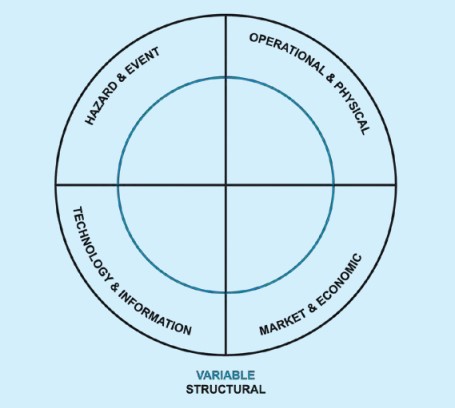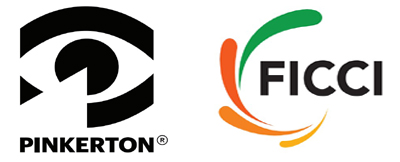FICCI and Pinkerton publish the India Risk Survey (IRS) report to identify possible business risks and difficulties prevailing in the Indian business landscape. The survey identifies 12 key areas of concern for businesses and 5 emerging risks that might seriously damage India’s business ecosystem. The results are derived from a survey that involved stakeholders and business executives from various industries.
The India Risk Survey Report is frequently seen as a significant predictor of the risks that Indian firms must deal with. Businesses use the report to evaluate their risk exposure and decide how to operate in India. In addition, the media and decision-makers frequently use the survey’s conclusions as proof of the difficulties experienced by Indian entrepreneurs.
The India Risk Survey Report gives valuable information about the risks that firms face, like Natural Hazards, Information & Cyber Insecurity, Intellectual Property Theft, Fire, and Crimes, and enables them to make defensible choices regarding their operations.
Surpassing the risk of Natural Hazards and pandemics, the risk focus has drastically shifted to Intellectual Property Theft and Information & Cyber Insecurity due to the increasing interconnectivity of businesses’ reliance on technology, and the vast amounts of data that are now stored electronically. Offices have been replaced by hybrid working arrangements, and growing digitization has accelerated the threat.
Cases of industrial accidents along with road accidents have been rising as they occur suddenly and without warning, often causing extensive damage to property and equipment. They can also lead to injuries or even fatalities, leading to both reputational and revenue damage for the business.
While business espionage is not a new phenomenon, but it has become more prevalent in recent years as the world of business has become more globalized. Companies are now operating on a much larger playing field and there is more at stake.
The goal of this survey is to identify potential risks in the context of a changing global environment, allowing business leaders to assess their circumspection for disruptive events like rapid digitalization, accidents, and business espionage, in the future and to ameliorate risk mitigation techniques. Nonetheless, based on each industry’s risk appetite and current risk mitigation plans, the risks identified and their effects may differ from one to the next.
The survey’s outcome should help organizations create a 360-degree risk management strategy that will allow them to foresee and prepare for any eventuality, limit interruption, and protect against any risks in advance.
 Rohit Karnatak
Rohit KarnatakVice President – India
APAC & EMEA
Global Screening, Pinkerton
The India Risk Survey has successfully reached its 10th year milestone, and I feel very proud to say that this survey report has helped many organizations (both private and public sector) in identifying, safeguarding themselves from the potential or prevailing risks in this dynamic business environment and also helps them to create a strategy for their risk governance.Over the years as we introduced the Pinkerton Risk Wheel which has now matured to a more comprehensive risk governance. Risk governance involves how effectively organizations are managing risks by establishing policies, procedures, and frameworks so that the business operates in a responsible and sustainable manner. Effective risk governance is when it is implemented at the planning and strategic level of the decision-making process in an organization. To make it more effective, one should engage with subject matter experts or consulting firms who have expertise in the risk advisory domain.
This year’s risk survey has outlined the top 3 risks which are Intellectual Property Theft, Information & Cyber Insecurity, and Accidents ranked in that order.
The industry leaders ranked Intellectual Property (IP) Theft as the risk which is the most prevalent threat to their business. Until 2019, IP Theft was not a part of the top 5 risks, but from 2021 it started to emerge among the top 3 risks and finally making to the number one risk this year. When we delved deeper, we could understand that the Indian businesses are understanding the processes, innovations and techniques too are valuable to a business and thus needs to be adequately protected. In the initial years of the report, most businesses only identified counterfeiting of products or violation of trademarks as an IP risk. The manufacturing of a product or the process of a service both are like soft power and need protection as much as the counterfeit product/service that may have been introduced in the market.
Pinkerton globally have been focusing on this risk and have been helping organizations make strategies to protect these Intellectual Properties via with the help of Pinkerton’s Global Investigation Services with a dedicated service line of Intellectual Property Protection Service.
India Risk Survey 2022 also highlights the top 5 emerging risks which have been prevailing in this past year of 2022 and posed a threat to businesses. The most prevalent emerging risk was the ‘Safety and Security of Key Personnel,’ This risk has emerged at the top because of the threats present for the C-Suites and Directors both internally as well as externally of their business premises. The need for a safe work environment along with the safety & security required during the executive’s business travels has increased manifolds in recent times and therefore, organizations are opting for Executive Protection Services to protect their key personnel from these threats.
If an organization keeps risk governance at the center when planning their risk strategies and looks beyond the realm of just compliance, it will help the organization to have an effective, comprehensive risk mitigation covering all four quadrants of risk. We hope that the report will add value to your organization’s risk governance strategy.
SUMMARY
Each year, the India Risk Survey (IRS) gathers 12 risks that, in the opinion of business enterprises and subject-matter experts, represent the most significant threats that might disrupt Indian business operations. To comprehend and evaluate each risk independently and to conduct analysis, the survey employs the Pinkerton Risk Wheel structure. The Pinkerton Risk Wheel has four different risk categories. Based on the type of threats, the risks are classified. Each quadrant has some of the risks listed under each category that are interrelated. The four quadrants in the risk wheels are Hazard & Event Risk (natural hazards, crime, terrorism & insurgency, and fire), Operational & Physical Risk (strikes, closures & unrest, threats to women’s safety, and accidents), Market & Economic Risks (corruption, bribery & corporate fraud, and political & governance instability), and Technology & Information Risk (business espionage, information & cyber insecurity, and intellectual property theft).

An effective risk management strategy will address the most significant risks across all categories. By taking a 360-degree approach to risk management, organizations can effectively protect themselves from the potentially devastating effects of risk. For 360-degree mitigation and management, the India Risk Survey 2022 determines the most prevalent threat categories for each risk. The risks emphasized in this study are interrelated and cross over into other industries, sectors, and topographies.
Intellectual property theft, known as IP theft, is the unauthorized borrowing or reuse of original concepts, inventions, or other material by third parties. Companies increasingly derive value from their processes, ideas, and innovations as the world transitions to a knowledge-based economy. For companies of all sizes, intellectual property theft is a censorious issue. As a result, companies may lose millions of dollars in income, and their reputations may also suffer. Hacking into business computers, stealing original papers, and even eavesdropping on meetings are some of the ways that thieves might use to gain access to intellectual property. Intellectual property-related risks, including counterfeit goods, brand reputation loss, patent & trademark infringement, IP legal framework, and other similar issues, can lead to the loss of revenue, harm a company’s reputation, and result in legal liabilities.
Information and cyber theft refer to the illegal stealing of private information belonging to another person or organization without that person’s consent. The risk of cybersecurity breaches is real and growing in the current business landscape. Cybercriminals target businesses of all sizes, and the stakes are high – a successful attack can result in the loss of sensitive data, financial loss, and damage to reputation. Moreover, it can be done by innumerable illicit practices like phishing, using malware to corrupt the system or the network, and SQL injections to debauch the database, which can severely affect the integrity and security of the company. Cybersecurity threats, like data theft/ phishing/hacktivism, compliance/regulatory incidents, domain-based attacks, executive threats/ impersonations/social media perils, and other cyber-related risks which can harm a company’s reputation leads to the loss of confidential data, and result in legal liabilities.
Accidents at work may significantly affect any company, as they can reduce productivity, decrease sales, lower employee morale, damage reputation, and, in the worst-case scenario, force closure. Industrial accidents can have a devastating effect on businesses. The loss of life, injuries, damage to equipment and buildings, and shutdown of operations can lead to substantial financial losses. In addition, the negative publicity surrounding an accident, whether it is a road accident or an industrial accident, can damage a company’s reputation eventually leading to loss of customers and business. Traffic accidents, forces of nature such as lightning, heat stroke, and landslides, factory/ machine accidents, crowd mismanagement, and other related incidents can lead to business interruption, supply chain disruptions, and regulatory fines.
Business espionage often referred to as corporate spying, economic espionage, or industrial espionage refers to stealing a company’s essential data and information. One of the most obvious ways business espionage can affect a company is by stealing its trade secrets. This can give the competitor an unfair advantage and lead to lost business and revenue for the victim company. The paranoia and mistrust that business espionage fosters among employees is another way that it can harm a firm. Risks, like vendor bribing, employee poaching, and other unethical practices, can result in reputational damage, the loss of business opportunities, and legal liabilities.
Women Safety threat – Despite strict legislation such as the POSH Act of 2013, Women might physiologically suffer from occupational health threats and sexual harassment, which can cause serious mental health problems. Fear of victimization causes women to alter their activities. It impacts the economy as a whole and enterprises in India. Sexual harassment-related issues, like eve-teasing, abduction, sexual favors at the workplace, sexual assault, and other similar risks, can lead to legal liabilities, reputational damage, and loss of employees.
A natural hazard is a threat of a naturally occurring event that may harm people or the environment. There are several risks connected to natural disasters which can also have grievous effects on enterprises. For instance, extreme weather can impede supply chains and transportation networks while also causing infrastructure and property damage. Wildfires and flooding both have the potential to destroy property, interrupt business, and force evacuations. Natural disasters can cause disruptions in supply chain management and equipment loss, leading to revenue loss just like the COVID 19 pandemic did.
 Manjari Jaruhar
Manjari Jaruhar
Advisor
FICCI Committee on
Private Security Industry
Businesses are heading towards a very uncertain era and therefore, knowing our risks in advance could help us better planning their management. With an objective to sensitise businesses about the changing risk landscape in India, FICCI in partnership with Pinkerton instituted an annual exercise of gathering industry perception about different kinds of risks and publish the consolidated opinion in the form of risk ranking in an analytical report.
We entered 2022 wishing not to repeat the horrible experience of the first quarter of 2021 which witnessed the deadliest form of COVID 19 outbreak claiming lives of people around us every single day. As the businesses around the world started gaining in their volumes and activities, another disruption hit us in the form of Russia – Ukraine war, ushering in a different scenario of food and energy crises, financial uncertainties, increased cost of living and global MNCs shedding jobs and budgets.
On the policy front, a lot of brave decisions were taken by the Government to improve the internal issues and also to present India in the avatar of the Vishva Guru (World Leader). These measures have played a key role in developing resilience in the economy.
Vision of Atmanirbhar Bharat (self-reliant India) started translating into sectoral polices, regulations and creation of products & solutions, be it defence, green energy, health or digital currency. Enormous efforts have been made to relax the procedural and compliance burden on industry which resulted in improved ranking of the country under the Ease of Doing Business index. The World Bank also acknowledged that the Indian economy has been remarkably resilient to the deteriorating external environment, and strong macroeconomic fundamentals have placed it in good stead compared to other emerging market economies.
Scientific know-how (like pharmaceutical, space, marine and environmental science) and application of cutting-edge technologies like cyber, AI/ ML, drones, geospatial, robotics, are seen in the forefront of most of the transformational mission mode projects. Industry and especially startups are encouraged to partner with government and academia to develop India, not only as a manufacturing and export hub but also as a centre for generating knowledge and creating intellectual property.
India Risk Survey 2019 had set an alarm by ranking Natural Hazard as the second topmost risk for businesses which became number one risk in 2021. However, with the risk emerging due to climate change, compliance related to use of energy, water, emissions, disposal of hazardous substance and synthetic compounds are getting more alarming. Likewise at midst the technology threats posed by cyber criminals and rogue drones, policies to regulate intervention by stakeholders in technology space are also taking shape gradually while making them more participatory for private sector.
In nutshell, risk landscape is cyclic and the major parameters will keep on shifting depending upon the external factors, the need is to see the spectrum as a whole and plan your strategy accordingly. I hope, you will find India Risk Survey 2022 report useful to understand the risk profile of your organisation and create an appropriate risk mitigation strategy.
When it comes to fire safety, there are a lot of possible concerns that organizations might encounter. Using combustible materials, electrical equipment, and culinary appliances can provide operational hazards that increase the possibility of a fire breaking out on a corporate property. Also, ineffective fire safety management may raise the probability of a fire. When a fire breaks out at a place of business, the results can be disastrous as it may affect the viability of the enterprise along with the physical damage that occurs on the business premise. A fire can also have a significant negative impact on the company, disrupting operations and resulting in financial loss. Fires caused by electric short circuits, chemical-based incidents, and gas cylinder/stove bursts, can cause harm to people and property, interrupt business operations, and cause revenue losses.
No company is safe from crime. Businesses may unintentionally participate in a crime or become its victims. In addition, crime may significantly affect a business regarding direct and indirect expenses. For example, in regions where drug trafficking or arms trafficking is prevalent, businesses may face higher levels of violence, theft, and corruption. This can make it challenging to operate effectively and creates an unstable business environment. Similarly, kidnapping, extortion, and burglaries can lead to financial losses and impact the safety of employees and customers. The price of stolen products, the price of repairs following a breakin, and the price of more stringent security measures are some examples of the direct costs of crime. The indirect costs, sometimes more challenging to calculate, might include lost clients, lost employees, and reputational harm to the company.
Inefficiency and other administrative failings have plagued and continue to confront varying degrees of cultures worldwide. Political instability can have a multitudinous influence over many areas of business risk, specifically the effects of a country’s financial and economic situation. The Indian political landscape has been volatile in recent years. This has made it difficult for businesses to plan for the future. Centre-state conflicts can create a significant level of uncertainty in a country, which can negatively impact businesses operating in the affected states. State fragility, policy changes, local government instability, and international conflicts can lead to supply chain disruptions. These conflicts can take various forms, such as disagreements over resource sharing, jurisdictional boundaries, political control, and ideological differences. However, India’s standing in the world’s Ease of Doing Business rankings has significantly improved in recent years. Several business-friendly initiatives and policy decisions made by the federal, state, and local governments are important contributors for the aforementioned.
Corruption may have a high financial cost. Bribery and corruption may force corporations to pay more for goods and services. This may result in lower profit margins and harsher competition. Inefficiencies can also be brought on by corruption. Unethical business practices, like bribery/kickbacks, shell companies, conflict of interest, business identity theft, and other such issues, can lead to legal liabilities, reputational damage, and a loss of business opportunities. For instance, a business would need to submit extra paperwork or go through additional approval procedures to complete tasks. Time and money may be lost in this. Reputational harm is another price of corruption. A company’s reputation may suffer, and it may be more challenging to secure new business if it is discovered to have bribed authorities or engaged in other corrupt activities.
Any organized absence from work by a group of workers or employees in favor of a demand they have made is referred to as a strike. These include work slowdowns, go-slows, overtime restrictions, and work-to-rule. Strikes can have a significant impact on businesses, both in the short and long run. In the short run, businesses may have to deal with lost production, increased costs, and disruptions in their operations. Union/labor strikes, civil unrest, political violence, regulatory changes, and other labor-related issues, can interrupt business operations, result in the loss of revenue, and may harm the company’s reputation. In the long run, strikes can damage relationships with customers and suppliers and lead to a loss of business.
Terrorism is the deliberate, coordinated, and routine use of force to achieve political, religious, or ideological ends. Terrorist threats, includes active shooter/ suicide bombers/ insider threats, explosives, CBRNE, narco-terrorism, and other similar risks that can result in the loss of life, damage to property, and restrict a range of economic activities. It has spread globally and severely threatens world peace, security, and stability. In addition, business groups spend more on security due to insurgency. This results in paying for private security services and safeguards.
RISK TREND 2022
Intellectual property theft, information & cyber security threats, and accidents were ranked as the top three business threats in India by survey respondents for this year’s India Risk Survey. In contrast, ‘Threats to Women Safety’ rose from 12th place in 2021 to 5th place in 2022. With increasing reports of violence against women, it has become clear that companies must take measures to ensure the safety of their women employees and customers. According to survey participants in India, this year, the lowest risk is associated with terrorism & insurgency.
Intellectual Property Theft has swarmed up to the top spot. Since, business intellectual property can be swiftly monetized, therefore, cybercriminals and dishonest personnel frequently target it. These personnels and cybercriminals seize several chances in this digital age to secretively duplicate trade secrets, copyrights, patents, and trademarks and sell them to rivals. By proactively identifying these risks, corporates can think about adding a new business-focused strategy to contracts and legal remedies for revamped IP Management.

Information & Cyber Insecurity has retained its second position because businesses are becoming more exposed to cyber thieves as they have started to store more of their data online. Rapid digitalization along with hybrid working models have led to data thefts, ransomware, disrupted business, and tarnished brand equity which has increased the financial burden for the industries. Assessing the viability of different security risks in businesses and determining the effects of cyberattacks are the major goals of risk identification. Based on this information, an effective security system can subsequently be built to protect the IT systems from ‘Hacktivists.’
Accidents have been ranked at third position as frequency of accidents have increased in the recent times resulting in severe physical and/or mental harm to employees. Accidents also impacts the business financially as additional cost is borne by the firms in terms of victim compensation and financial loss due to production halt. It also negatively impacts the company’s reputation in the market. Businesses should put a great deal of effort into preventing workplace accidents at all costs by using state-of-art technology and creating a secure workplace for their valued employees.
Business Espionage which is ranked at the fourth position entails the use of listening or monitoring devices, covert cameras, and transmitters, as well as cyberattacks in which systems are compromised and sensitive data is accessed, copied, or stolen. Business espionage is occasionally carried out by spies who infiltrate companies to gain confidential information by stealing or copying data or searching through paper trash, among other methods. These spies may be current or past workers, housekeepers, contractors, or trespassers. Businesses should take holistic measures to safeguard their trade secrets and be vigilant and keep an eye out for their competitors’ activities.
Women experience discrimination and harassment from their co-workers at work regularly which has become more evident as Threats to Women Safety has been ranked at fifth position this year. The workplace has evolved into a considerably more diversified environment during the last three decades. Personal security and safety has become essential to women’s physical, intellectual, emotional, economic, and spiritual well-being in India, where women constitute 22.2% of the workforce. Quid pro quo and hostile working environment is causing a lot of women to go through psychological and physiological trauma, which compels them to leave their jobs. This causes a lot of revenue and reputational damage to the firms. Companies should adopt efficacious sexual harassment policies, create awareness, and set up an Internal Complaints Committee (ICC) for woman grievance where they can freely express themselves.
